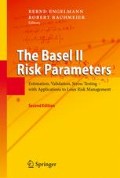Abstract
A key attribute of a rating system is its discriminative power, i.e., its ability to separate good credit quality from bad credit quality. Similar problems arise in other scientific disciplines. In medicine, the quality of a diagnostic test is mainly determined by its ability to distinguish between ill and healthy persons. Analogous applications exist in biology, information technology, and engineering sciences. The development of measures of discriminative power dates back to the early 1950s. An interesting overview is given in Swets (1988).
Access this chapter
Tax calculation will be finalised at checkout
Purchases are for personal use only
Notes
- 1.
The terminology rating category or rating score is used interchangeably throughout this chapter.
- 2.
In principle, AR could be negative. This would be the case when the ranking of the debtors by the rating system is wrong, i.e., the good debtors are assigned to the rating categories of the poor debtors.
- 3.
A rating system with an AUROC close to zero also has a high discriminative power. In this case, the order of good and bad debtors is reversed. The good debtors have low rating scores while the poor debtors have high ratings.
- 4.
The inversion of the likelihood ratios is not necessary. We are doing this here just for didactical reasons to ensure that low credit quality corresponds to low rating scores throughout this chapter.
- 5.
Efron and Tibshirani (1998) is a standard reference for this technique.
- 6.
In (13.8) the ½ has to be replaced by 0, and the 0 has to be replaced by −1 to get the corresponding Mann-Whitney statistic for the AR.
- 7.
See also Blochwitz et al. (2005).
References
Blochwitz S, Hamerle A, Hohl S, Rauhmeier R, Rösch D (2005), Myth and Reality of Discriminatory Power for Rating Systems, Wilmott Magazine, January, pp. 2–6.
DeLong E, DeLong D, Clarke-Pearson D (1988), Comparing the Areas under Two or More Correlated Receiver Operating Characteristic Curves: A Nonparametric Approach, Biometrics 44, pp. 837–845.
Efron B, Tibshirani RJ (1998), An Introduction to the Bootstrap, Chapman & Hall, Boca Raton, FL.
Engelmann B, Hayden E, Tasche D (2003a), Testing Rating Accuracy, Risk 16 (1), pp. 82–86.
Engelmann B, Hayden E, Tasche D (2003b), Measuring the Discriminative Power of Rating Systems, Working Paper. http://www.bundesbank.de/download/bankenaufsicht/dkp/200301dkp_b.pdf.
Hamerle A, Rauhmeier R, Rösch D (2003), Uses and Misuses of Measures for Credit Rating Accuracy, Working Paper.
Lee WC, Hsiao CK (1996), Alternative Summary Indices for the Receiver Operating Characteristic Curve, Epidemiology 7, pp. 605–611.
Lee WC (1999), Probabilistic Analysis of Global Performances of Diagnostic Tests: Interpreting the Lorenz Curve-Based Summary Measures, Statistics in Medicine 18, pp. 455–471.
Sobehart JR, Keenan SC (2001), Measuring Default Accurately, Risk 14, pp. S31–S33.
Sobehart JR, Keenan SC, Stein RM (2000), Benchmarking Quantitative Default Risk Models: A Validation Methodology, Moody’s Investors Service.
Swets JA (1988), Measuring the Accuracy of Diagnostic Systems, Science 240, pp. 1285–1293.
Tasche D (2002), Remarks on the Monotonicity of Default Probabilities, Working Paper. http://www-m4.ma.tum.de/pers/tasche/monoton.pdf.
Author information
Authors and Affiliations
Corresponding author
Editor information
Editors and Affiliations
Appendices
Appendix A. Proof of (13.2)
We introduce the shortcut notation \( \hat{C}_D^i = {\hat{C}_D}\left( {{R_i}} \right) \), \( \hat{C}_{ND}^i \)and \( \hat{C}_T^i \)have a similar meaning. Furthermore, we denote the sample default probability by \( \hat{p} \). Note that \( \hat{C}_T^i \)can be written in terms of \( \hat{C}_{ND}^i \)and \( \hat{C}_D^i \)as
By computing simple integrals, we find for AUROC, a R + 0.5, and a P the expressions
Plugging (13.23) into the expression for \( {a_R} + 0.5 \)and simplifying leads to
Taking (13.24) and (13.25) together leads to the desired result
Appendix B. Proof of (13.7)
Using the same shortcut notation as in Appendix A, we get
which proves (13.7).
Rights and permissions
Copyright information
© 2011 Springer-Verlag Berlin Heidelberg
About this chapter
Cite this chapter
Engelmann, B. (2011). Measures of a Rating’s Discriminative Power: Applications and Limitations. In: Engelmann, B., Rauhmeier, R. (eds) The Basel II Risk Parameters. Springer, Berlin, Heidelberg. https://doi.org/10.1007/978-3-642-16114-8_13
Download citation
DOI: https://doi.org/10.1007/978-3-642-16114-8_13
Published:
Publisher Name: Springer, Berlin, Heidelberg
Print ISBN: 978-3-642-16113-1
Online ISBN: 978-3-642-16114-8
eBook Packages: Business and EconomicsEconomics and Finance (R0)

